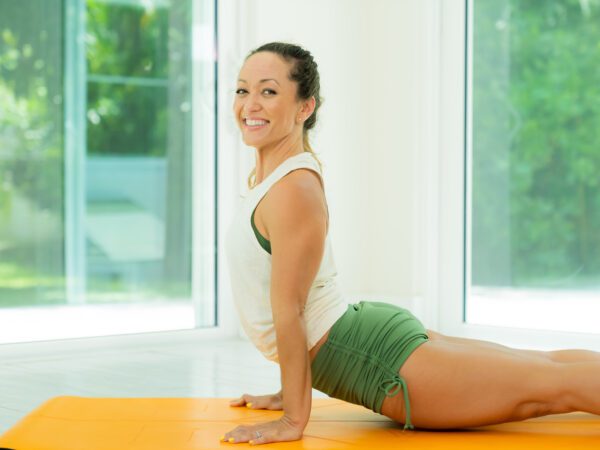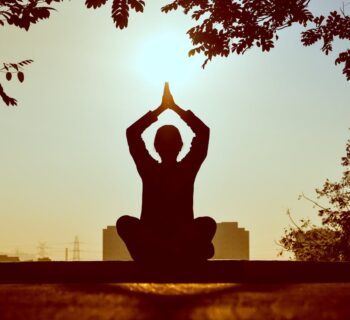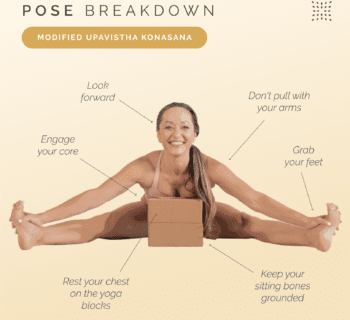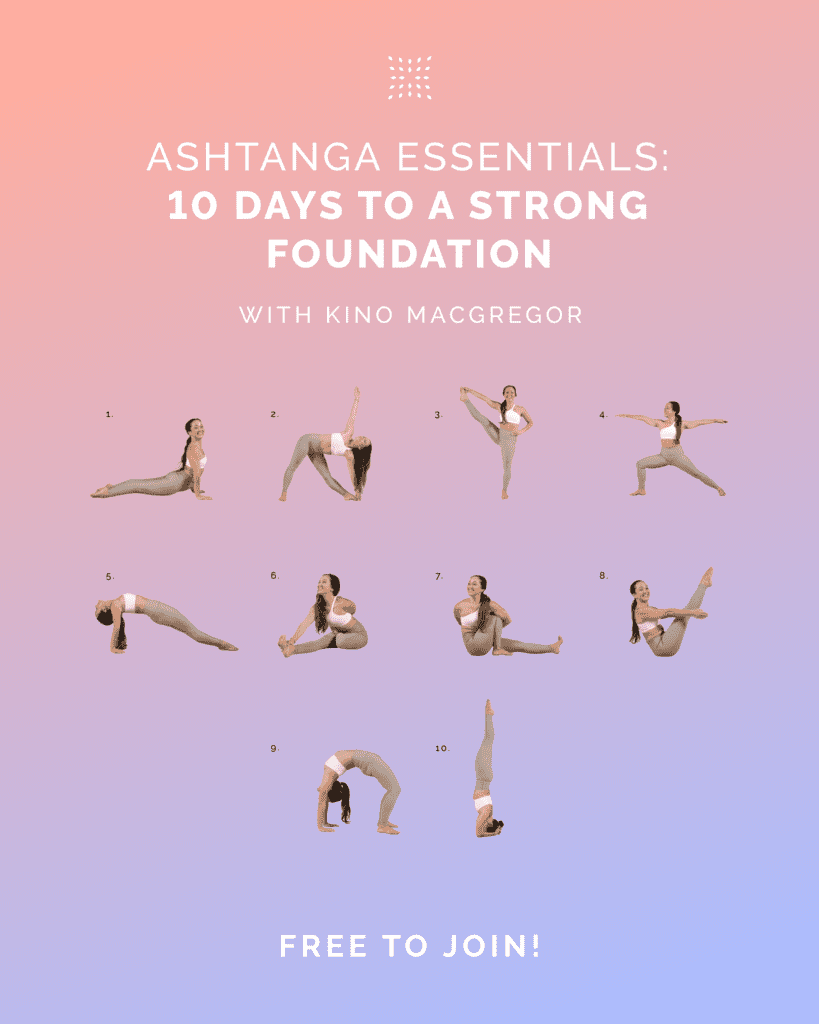Is your life like a stormy sea?
Restorative yoga serves as the anchor, gently guiding us to balance and stress relief, offering serenity against life’s tumultuous waves. Experience its transformative power today.
Understanding Restorative Yoga
Restorative yoga is a deeply relaxing practice that emphasizes rest and healing through supported poses, long holds, and mindfulness. Its origins can be traced back to the mid-20th century and are rooted in the teachings of B.K.S. Iyengar, a renowned Indian yoga teacher who revolutionized modern yoga with his precise focus on alignment and the use of props. Iyengar developed the use of bolsters, blankets, straps, and blocks to help practitioners achieve poses comfortably, enabling them to remain in these postures longer, which is one of the hallmarks of restorative yoga.
The person most credited with formalizing restorative yoga as a distinct practice is Judith Hanson Lasater, a long-time student of Iyengar. In the 1970s, Lasater began developing restorative sequences that integrated Iyengar’s principles of alignment and support while emphasizing rest as a form of healing. She recognized the need for a practice that allowed people to deeply relax and recover from stress, illness, or injury. This approach shifted yoga from a more physically demanding practice into one that focuses on releasing tension and finding deep rest through minimal effort.
Restorative yoga has gained popularity in recent decades as people seek ways to manage stress and promote mental and physical recovery. By creating an environment where the body is fully supported, restorative yoga allows the nervous system to shift from a state of “fight or flight” to “rest and digest.” This practice has since become a valuable tool for wellness, often used to combat the effects of a fast-paced lifestyle, chronic stress, and fatigue, making it an important aspect of modern therapeutic yoga.
Benefits of Restorative Yoga for Stress Relief
In a world that constantly demands our attention, restorative yoga serves as a transformative sanctuary, offering profound stress relief through its gentle and intentional practice. This serene discipline encourages relaxation and fosters a deeper connection with oneself.
Restorative yoga enables the release of accumulated tension. It cultivates an environment where stress no longer dictates our emotional and physical state. Consequently, this practice effectively reduces cortisol levels (a hormone associated with stress) and anxiety.
Through supported poses and mindful breathing, restorative yoga allows the nervous system to reset and invites the calm before the storm of daily life. It creates a space where the relentless pressures of the outside world dissipate.
Practicing restorative yoga consistently can lead to improved mood, enhanced concentration, and increased resilience against stressors, highlighting its vital role in holistic well-being. Moreover, it guides practitioners to embrace the stillness within.
Many find that restorative yoga not only alleviates stress but also enhances their overall quality of life, providing an opportunity to rediscover joy, balance, and centeredness in all aspects of daily living.
It’s not just about finding peace; it’s about crafting a life where stress does not overshadow joy. Embrace restorative yoga as an essential guide to harnessing tranquility amidst life’s turbulent waves.
Essential Props for Restorative Yoga
Creating a Restorative Yoga Space at Home
Crafting a restorative yoga space at home begins with creating an environment that cultivates peace and equilibrium for your practice.
The primary objective is to curate an atmosphere that encourages relaxation and mindfulness, promoting a retreat from daily chaos. This can be accomplished by selecting a quiet corner and adorning it with calming elements like soft lighting, soothing colors, and natural textures. A gentle ambiance, paired with subtle aromatherapy such as lavender or chamomile, enhances the serenity and invites introspection, creating a dedicated haven.
Ensure your space is a clutter-free sanctuary of minimal distractions. By organizing yoga accessories, such as mats and props, neatly within reach, you cultivate an area conducive to sustained tranquility and effortless meditation, allowing the restoration of energy and focus.
This thoughtfully designed space becomes a conduit for rejuvenating body, soul, and relationships, reinforcing your commitment to balance and wellness. The comfort of a welcoming home sanctuary will enrich your restorative yoga practice, making each session a refuge of calm that reinforces inner harmony and resilience, empowering you to face the world refreshed and renewed.
Key Restorative Yoga Poses
The art of restorative yoga is grounded in specific poses designed to nurture both the body and spirit, offering profound relaxation and healing. These poses, often supported by props like bolsters, blankets, and eye pillows, allow practitioners to delve deep into a calm state, releasing stress and fostering a renewed sense of balance and equilibrium.
These essential postures include the heart-opening supported backbend, the soothing legs-up-the-wall pose, and the grounding child’s pose. Each of these positions encourages deep rest and rejuvenation.

Supported Supta Baddha Konasana (Reclining Bound Angle Pose)
Supported supta baddha konasana (reclining bound angle pose) is a deeply restorative posture often practiced in restorative yoga to promote relaxation and gentle opening of the hips, chest, and groin. In this pose, the body reclines with the soles of the feet together and the knees falling outward, creating a soothing stretch through the inner thighs and pelvis. It is typically supported by props to ensure the body is fully comfortable and able to rest without tension.
To set up for this pose, a bolster or blanket is placed lengthwise along the spine, providing support for the back and head, allowing the chest to gently open. Blankets or blocks are placed under the knees or thighs to support the legs, preventing strain on the hips and inner thighs as they relax outward. The use of an eye pillow can enhance relaxation by blocking out light and promoting a sense of calm. Sometimes, an additional blanket can be draped over the body for warmth and comfort during longer holds.
The primary purpose of supported supta baddha konasana in restorative yoga is to encourage deep relaxation while gently stretching the body in a passive, supported way. This pose is particularly effective for relieving stress, calming the mind, and opening the heart and hip area without any effort. The use of props ensures that the body feels fully supported, allowing for the deepest level of rest and rejuvenation.
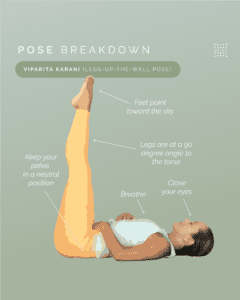
Legs-Up-The-Wall Pose
The restorative power of the legs-up-the-wall pose lies in its simplicity and profound relaxation, making it an ideal antidote to our fast-paced world.
By positioning your legs vertically against the wall, you create a gentle inversion that aids in calming the nervous system, reducing anxiety, and enhancing overall circulation. This gentle elevation of the legs allows the blood to flow seamlessly back towards the heart, promoting a sense of balance and tranquility. It also encourages a harmonious signal to your body that it’s time to shift into rest and recovery mode.
This pose provides an accessible opportunity for muscles in the lower back to unwind. As you settle into this position, gravity naturally assists in releasing tension that often accumulates due to prolonged sitting or standing, allowing you a moment of complete surrender and regeneration.
To practice, transition smoothly into a comfortable position close to the wall, extending your legs upward, while supporting your back with a bolster, if desired. Allow the transformative stillness to wash over you as you close your eyes and embrace the velvety quiet, nurturing both mind and body. Though seemingly simple, this position can become an integral resource in your restorative yoga practice, redefining how you experience rest and recovery, and empowering you to meet each day with renewed zest and poise.
Breathing Techniques in Restorative Yoga
At the heart of restorative yoga lies the profound grace of breath work, a pivotal element of this gentle practice. Engaging with deliberate, mindful breathing techniques unveils a symphony of benefits.
Restorative breathing guides you to a state of heightened relaxation and tranquility. Deep inhalations invite peace.
Techniques such as abdominal breathing, also known as diaphragmatic breathing, anchor you profoundly. This bedrock of restorative yoga profoundly calms the nervous system.
Another practice involves alternate nostril breathing, harmonizing your inner energies. This technique exudes a serene rhythmic flow.
Here, the rhythm of your breath becomes an ally in diffusing stress layers, propelling your body into efficacious relaxation states. The cadence of inhaling and exhaling fosters equilibrium within.
Through, deeply connecting with breath’s embrace, you’ll discover transformative calm. Restorative breathwork greatly enriches inner stillness, inspiring confidence and resilience.
Developing a Restorative Yoga Routine
The journey towards cultivating a restorative yoga routine begins with carving out time for yourself. By choosing a consistent time each day, you prioritize the sacred semblance of restoring balance, much like a symphony orchestrating calm amidst chaos. Gradually, delve into the nuances of integrating these calming postures to accentuate the breath’s gentle rhythm.
Consider starting with familiar poses.
The child’s pose or the reclined butterfly are excellent beginnings – with their gentle, therapeutic cradle of support – and seamlessly transition into more advanced multi-faceted sequences. Remember, each pose should encourage profound relaxation.
As you build your routine, incorporate holistic mindfulness practices that synchronize seamlessly with your aspirations for flourishing in work and life. Here is a brief restorative yoga practice you can add to your daily routine.
Incorporating Mindfulness in Your Practice
Incorporating mindfulness into your restorative yoga practice elevates the experience. This holistic approach not only enhances the immediate benefits of relaxation but opens the gateway to lasting equilibrium. By weaving awareness and presence into each breath, practitioners find themselves gently guided toward a harmonious fusion of mind and body that fosters authentic tranquility.
Mindfulness transforms routine into a profound journey.
Focus on being present in each motion – as each pose not only offers sanctuary through its physical alignment but also serves as a beacon for stress alleviation. This deliberate presence amplifies self-awareness, turning each session into a meditative dialogue.
By embracing mindfulness, you unlock transformative pathways where intentional tranquility escorts you to unimaginable realms of calm. These awakened moments fortify not only your existing restorative practices but also pave the way for innovative, elevated experiences on the mat and beyond. Let mindfulness be your compass to serenity, guiding you toward a life of profound balance and enlightened peace.
Common Restorative Yoga Mistakes to Avoid
In the pursuit of profound relaxation, avoiding key mistakes can enhance your overall restorative yoga experience.
Firstly, many restorative practitioners often overlook the importance of creating a supportive environment for their practice. Ignoring the ambiance, such as lighting and temperature, can detract from the tranquility essential for deep relaxation. Customize your space with soothing elements to cultivate an inviting sanctuary.
Additionally, failing to utilize props effectively is a pervasive oversight. When used improperly, props like bolsters and blankets may not provide the intended support, potentially diminishing the practice’s benefits. Take time to familiarize yourself with each prop to maximize their restorative potential.
Lastly, not allocating adequate time for poses can significantly impede your journey to restoration. Restorative yoga thrives on prolonged postures, allowing the body and mind to fully immerse in the experience. Prioritize setting aside ample time for each session, ensuring that you reap the full spectrum of restful and balancing benefits.
Tips for Long-term Stress Management with Yoga
Consistent practice is your greatest ally.
Embracing yoga as a daily ritual can significantly benefit stress management. The gentle nature of restorative yoga enables you to tap into the intrinsic peace within, revitalizing your life and guiding you toward a balanced existence. Moreover, evolving your practice into a meditative journey fosters the resilience needed to navigate life’s fluctuations.
Incorporate mindfulness techniques alongside your routine.
These practices invite embodied awareness through yoga, enhancing the sense of release and renewal. Explore breathing exercises that calm the mind and empower your emotional intelligence—a vital component on the path to harmony.
Join Omstars for instant access to hundreds of restorative yoga classes you can practice with in the comfort of your own home.
Photo by cottonbro studio: https://www.pexels.com/photo/woman-in-black-tank-top-sitting-beside-man-in-black-shirt-4327033/



